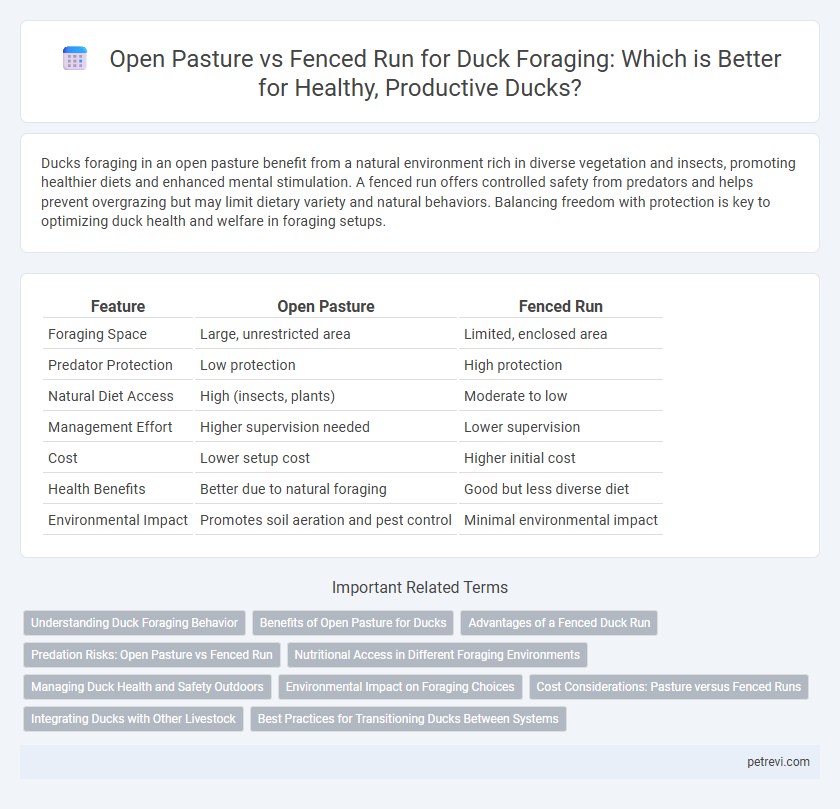Ducks foraging in an open pasture benefit from a natural environment rich in diverse vegetation and insects, promoting healthier diets and enhanced mental stimulation. A fenced run offers controlled safety from predators and helps prevent overgrazing but may limit dietary variety and natural behaviors. Balancing freedom with protection is key to optimizing duck health and welfare in foraging setups.
Table of Comparison
| Feature | Open Pasture | Fenced Run |
|---|---|---|
| Foraging Space | Large, unrestricted area | Limited, enclosed area |
| Predator Protection | Low protection | High protection |
| Natural Diet Access | High (insects, plants) | Moderate to low |
| Management Effort | Higher supervision needed | Lower supervision |
| Cost | Lower setup cost | Higher initial cost |
| Health Benefits | Better due to natural foraging | Good but less diverse diet |
| Environmental Impact | Promotes soil aeration and pest control | Minimal environmental impact |
Understanding Duck Foraging Behavior
Ducks exhibit natural foraging behaviors that thrive in open pasture environments, where access to diverse vegetation, insects, and aquatic life enhances their nutrition and overall health. A fenced run limits the variety of forage and can restrict natural movement patterns, potentially reducing the intake of essential nutrients found in wild plants and invertebrates. Understanding these behaviors highlights the benefits of open pastures for promoting instinctive feeding and improving welfare in duck farming.
Benefits of Open Pasture for Ducks
Open pasture provides ducks with abundant natural forage such as insects, worms, and diverse plants, leading to improved nutrition and enhanced flavor in their meat and eggs. This environment promotes natural behaviors like dabbling, foraging, and swimming, which contribute to better overall health and reduced stress. Access to open pasture also reduces feed costs and supports sustainable farming practices by enhancing soil fertility and biodiversity.
Advantages of a Fenced Duck Run
A fenced duck run provides secure foraging space that protects ducks from predators and prevents them from wandering off, ensuring focused grazing and reduced stress. It allows controlled access to patches of grass and insects, enhancing nutrient intake and promoting healthier growth. The physical boundaries simplify management by minimizing crop damage and maintaining consistent pasture quality.
Predation Risks: Open Pasture vs Fenced Run
Open pasture exposes ducks to higher predation risks due to lack of physical barriers, making them vulnerable to predators such as foxes, hawks, and raccoons. Fenced runs provide a controlled environment that limits access by terrestrial and aerial predators, significantly reducing the likelihood of attacks. Secure fencing combined with overhead netting offers an effective solution to protect ducks while allowing safe foraging opportunities.
Nutritional Access in Different Foraging Environments
Open pasture allows ducks access to a diverse range of natural vegetation, insects, and aquatic life, enhancing their intake of protein, essential fatty acids, and micronutrients. In contrast, fenced runs tend to restrict duck foraging to a limited diet often supplemented with commercial feed, potentially reducing the variety of nutrients consumed. Studies have shown that ducks foraging freely exhibit improved growth rates and richer nutrient profiles in their meat due to enhanced dietary diversity.
Managing Duck Health and Safety Outdoors
Open pasture allows ducks to forage naturally, promoting diverse nutrition and reducing parasite buildup due to constant movement. Fenced runs provide controlled environments that protect ducks from predators and prevent exposure to harmful contaminants but may limit dietary variety. Balancing open pasture access with secure fencing optimizes duck health by combining natural foraging benefits with enhanced safety measures.
Environmental Impact on Foraging Choices
Open pasture systems allow ducks to forage more naturally, promoting biodiversity and reducing soil compaction compared to fenced runs. Ducks in open pastures contribute to pest control and nutrient cycling, enhancing the local ecosystem's health. Fenced runs, while easier to manage, often limit the environmental benefits by restricting natural behaviors and concentrating waste.
Cost Considerations: Pasture versus Fenced Runs
Open pastures offer a cost-effective foraging environment for ducks by reducing the need for expensive fencing materials and maintenance, while providing natural food sources that lower feed expenses. Fenced runs require significant upfront investment in durable fencing, labor for installation, and ongoing repairs, but can better protect ducks from predators and manage land use. Balancing initial capital outlay and long-term operating costs is essential to determine the most economical choice for duck foraging systems.
Integrating Ducks with Other Livestock
Open pasture enables ducks to forage naturally alongside other livestock, promoting integrated pest management and nutrient cycling through diverse animal interactions. Fenced runs limit foraging space but provide controlled environments that reduce predation risk and overlapping grazing pressures. Combining open pasture with rotational fencing maximizes forage availability while maintaining health and productivity in multi-species farming systems.
Best Practices for Transitioning Ducks Between Systems
Transitioning ducks from a fenced run to an open pasture requires gradual exposure to new environments to enhance foraging efficiency and minimize stress. Begin by introducing ducks to the open pasture for short periods, increasing duration while monitoring predator risks and ensuring access to clean water and shelter. Implement rotational grazing practices to prevent overgrazing and promote natural foraging behaviors, optimizing diet diversity and overall flock health.
Open Pasture vs Fenced Run for Duck foraging Infographic

 petrevi.com
petrevi.com